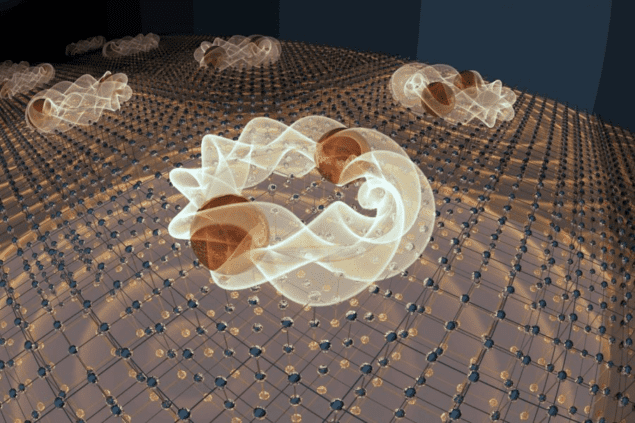
The first known superconductor in which spin-3/2 quasiparticles form Cooper pairs has been created by physicists in the US and New Zealand. The unconventional superconductor is an alloy of yttrium, platinum and bismuth, which is normally a topological semimetal.
The research was done by Johnpierre Paglione and colleagues at the University of Maryland, Iowa State’s Ames Laboratory, the Lawrence Berkeley National Laboratory and the Universities of Otago and Wisconsin.
Conventional superconductivity arises in a material when spin-1/2 electrons form “Cooper pairs” because of interactions between the electrons and vibrations of the material’s crystalline lattice. These pairs are bosons with integer (usually zero) spin, which means that at very low temperatures they can condense to form a state that conducts electrical current with no resistance.
Spin-orbit interaction
In the alloy studied by Paglione and colleagues, charge is carried by particle-like quasiparticles with spin-3/2. These quasiparticles arise from interactions between the spins of electrons and the positive charges of the atoms that make up the alloy. This effect is called spin-orbit coupling and is particularly strong in this material. The result is that the spin-3/2 state – which combines spin and orbital angular momentum – is the lowest energy state.
 Advertisement
Advertisement
When the team cooled the material, they found that it is a superconductor at temperatures below about 800 mK. This came as a surprise because this temperature is nearly 1000 times higher than expected if the superconductivity involved conventional Cooper pairs.
Paglione and colleagues also studied how magnetic fields penetrate the material. Superconductors can expel magnetic fields but the process is not perfect, with some magnetic field lines penetrating the surface of the material and persisting to small depths. Measuring this penetration effect gives important details about the nature of the pairing responsible for superconductivity.
Mind the gap
When the team measured the penetration depth as a function of temperature, they found that it increased linearly rather than exponentially – the latter being a characteristic of a conventional superconductor. This suggests that the energy gap between the superconducting and normal states of the material is not isotrophic in space, as is the case in conventional superconductors.
No one had really thought that this was possible in solid materialsJohnpierre Paglione, University of Maryland
This rules out spin-1/2 Cooper pairs so the team investigated other possibilities. They found that all possible pairings of spin-1/2 and spin-3/2 s in the alloy resulted in isotrophic gaps except the case where two spin-3/2 quasiparticles join to make a pair with a combined spin of 3.
“No one had really thought that this was possible in solid materials,” says Paglione, adding it “was quite a surprise given the simplicity of the electronic structure in this system”.
Non-trivial topology
What is particularly exciting about the material, say the researchers, is the topological nature of how the superconductivity arises. The spin-3/2 quasiparticles are a result of topology related to the strong spin-orbit coupling. Paglione also says, “the superconductivity that forms may itself have a non-trivial topology”. “This is a more subtle thing and harder to prove,” he adds, “but essentially the phase of the superconducting wave function may have a ‘twist’ in it that gives a non-trivial (chiral) topology. This has profound implications, such as possibility of Majorana fermion excitations from the superconducting condensate.” Indeed, an important fundamental question, says Paglione, is how the spin-3/2 fermions pair up in the first place. “What’s the glue that holds these pairs together?” he asks. “There are some ideas of what might be happening, but fundamental questions remain – which makes it even more fascinating.”Paglione says that spin-3/2 superconductivity could exist in other materials and the phenomenon could have technological and fundamental applications. If such superconductors are indeed topological, he believes that they could form the basis for fault-tolerant quantum computers. On a fundamental level, he says that spin-3/2 fermions provide a very rich spectrum of possible pairing configurations for physicists to study – adding that their work has already garnered significant interest from other physicists.
The research is described in Science Advances.
No comments:
Post a Comment